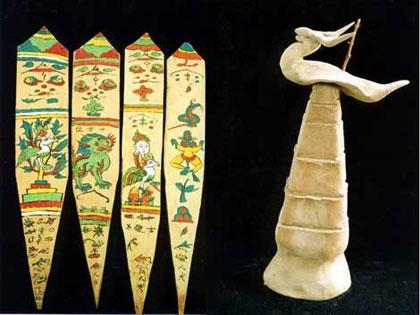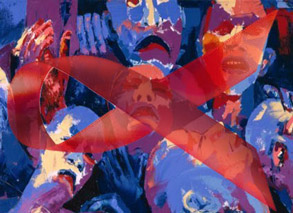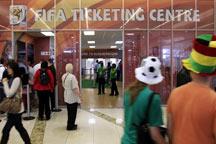 Apr. 5, 2025
Apr. 5, 2025
Weather
Dongba Art of Naxi
2009-08-11 13:39 BJT
Dongba Art is the primitive religious art special of the Naxi ethnics who live in the frontier area of southwest China and believe in Dongba religion. Dongba religion got its name from the fact that the priest of the religion is called "Dongba" by the people of the ethnic group. The religion has exerted very great influence on the material and spiritual lives of the Naxi people since ancient times. It has given birth to the time-honored Dongba culture, among which Dongba Art is the most glaring and beautiful part. The artistic forms include Dongba painting, Dongba literature, music and dance, so on and so forth. So it is a rich and colorful ethnic art treasure.
 |
| Dongba Art is the primitive religious art special of the Naxi ethnics who live in the frontier area of southwest China and believe in Dongba religion. |
Dongba paintings can be divided into wood chip paintings, card paintings, bamboo paintings and scripture paintings. They usually use gods, ghosts, spirit, people, animals and plants as well as the myth and legend of Dongba religion as the subjects. In the techniques and forms of painting, for the influence of foreign religions, especially Tibetan Buddhism, the primitive unsophisticated and natural character of Dongba painting is added with luxuriant color. Pilgrimage Road is the most representative work in the scroll paintings. Dongba literature which is represented by Dongba scripture describes various myth and artistic characters and the world that is full of romantic and wonderful things. The scripture is of very high literature value. Dongba music mainly refers to the arias when Dongba recites and sings the scripture in ceremonies and the cadence that Dongba takes part in the tutti of people in some ceremonies. The dance of Dongba on their sacrifice ceremonies is called Dongba dance, which has kept the characters of the primitive dances. There are various musical instruments which can be used to accompany the Dongba musical dance, usually including plate boll, copper gong, large drum, lute and so on.
To date, we can still detect the trace of pictograph in Dongba culture. Compared with other ancient characters in the world, Dongba pictograph can still be recognized, interpreted and adopted by the living Dongba, as a result, it is called "living pictograph". A lot of puppets, dough idols, clay sculptures and various bamboo and wood plaited articles made for religious and sacrifice ceremonies. These things are characterized by unique molding and vividness; thus, they reflect the artistic essence of Dongba Art. They are the genius works of arts of China's ethnic minorities.
Editor: Zhang Wen | Source: Cultural China Mail
Mail Share
Share Print
Print


 Video
Video









 2009 China Central Television. All Rights Reserved
2009 China Central Television. All Rights Reserved